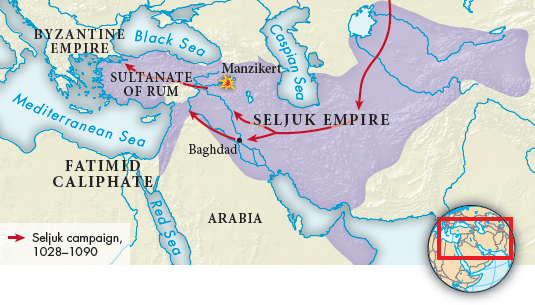Understanding World Societies:
Printed Page 245
The Ascendancy of the Turks
In the mid-

In the 1020s and 1030s Seljuk Turks overran Persia and then pushed into Iraq and Syria. Baghdad fell to them on December 18, 1055, and the caliph became a puppet of the Turkish sultan. The Turkic elite rapidly gave up pastoralism and took up the sedentary lifestyle of the people they governed.
The Turks brought badly needed military strength to the Islamic world. They played a major part in recovering Jerusalem after it was held for nearly a century, from 1099 to 1187, by the European Crusaders (who had fought to take Christian holy lands back from the Muslims; see “The Course of the Crusades” in Chapter 14). They also were important in preventing the later Crusades from accomplishing much. Moreover, the Turks became staunch Sunnis and led a campaign against the Shi’a.
The influx of Turks from 950 to 1100 also helped provide a new expansive dynamic. At the Battle of Manzikert in 1071, Seljuk Turks broke through Byzantine border defenses, opening Anatolia to Turkish migration. Over the next couple of centuries, perhaps a million Turks entered the area — including bands of ghazis and dervishes (Sufi brotherhoods, see “The Mystical Tradition of Sufism”).